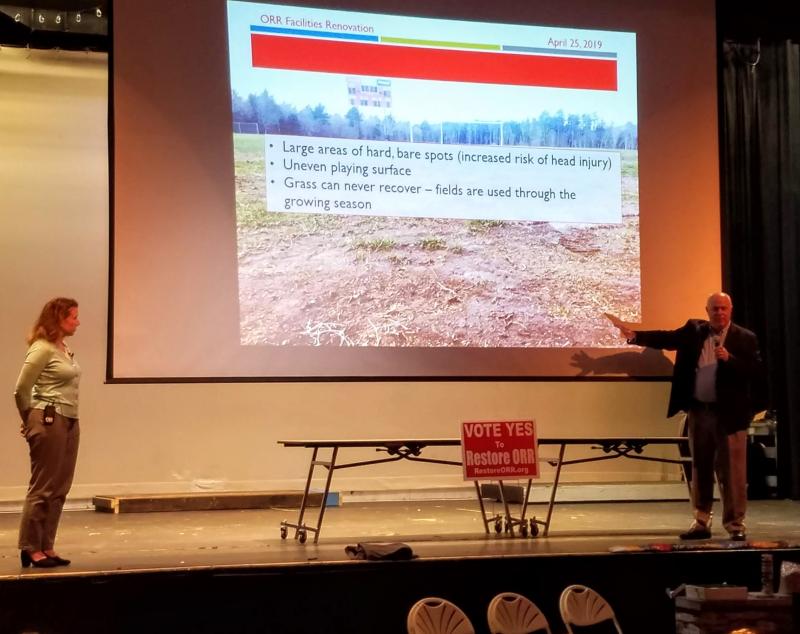Fielding questions on ORR field renovations
On the field at ORR, athletes risk tearing ACLs or twisting ankles. In the auditorium, stage techs manually move spotlights that “run hot” using oven mitts. It’s time for safer facilities, the school committee and other non-school groups say.
The proponents of a $2 million school renovation plan held a public information session on April 25 to allow voters to ask questions about the proposed renovation project, bringing in experts to provide some of the answers.
The proposal, currently set for a Town Meeting vote in all three towns, started in a private group (Tri-town Unified Recreational Facilities, or T.U.R.F) which got the support of the school committee. Now a second private group, Restore ORR, is also advocating for the project. The project also has multiple other proponents, including Lisa Cardoza, of Friends of Old Rochester Drama.
The project started as a $5 million ask, which included an overhaul of most of the athletic facilities. After community pushback, organizers scaled the plan down to focus on resurfacing the track, fixing its infield and installing artificial turf on the main field.
They also expanded the aim to include auditorium fixes, such as new, cooler LED lights and new wiring on the audio system.
The project would be funded with a “debt exclusion” from tax-limiting Proposition 2-1/2. A debt exclusion, which needs voter approval, allows a temporary tax increase above the Prop 2-1/2 limit to repay borrowing for a specific project.
If approved, renovations would cost the average homeowner an additional $19.57 a year in Mattapoisett, $25.11 a year in Marion, and $34.39 a year in Rochester under a 15-year debt-schedule. The cost in Rochester is highest because of the distribution of students.
“This school grounds is the most-used part of the tri-town, year-round, and the wear and tear is starting to show,” said Cary Humphrey, chair of the school committee adding that “a safe and secure place to go to school includes the facilities. And that doesn’t have to be the boiler.”
According to consultant Luke McCoy, from Kaestle Boos Associates, Inc, there is a real danger of the athletic facilities being judged too unsafe to use.
“It’s not an ‘if,’ it’s a ‘when’ that gets closed down,” he stated.
Organizers answered FAQs at the meeting, including why they want turf fields.
“We don’t have the space to let a [grass] field rest for a year,” said school committee member, Heather Burke, adding that when the school tried to give the fields a summer rest to regrow they fell apart within two games.
The school committee also told listeners what will happen if they don’t take any action.
For athletics it would mean more game cancellations by umpires or referees that judge the fields too unsafe to play.
A more serious risk is someone reporting the conditions to the Massachusetts Interscholastic Athletic Association, which could shut the fields down, both for games and practices, effectively ending the athletic programs, as the school does not have the budget to do all away games and bus kids to practice.
Audience members also asked why organizers chose 15 year bonds to finance the project when the track and field may have already reached the end of their useful life at that point.
School committee members and McCoy explained that currently turf fields last for about 10 to 12 years, but with ever-improving materials they may last longer. Tracks usually last about 20 years.
They added that when turf wears out, fixes would not be as expensive as initial installation because drainage basin and pad underneath the recyclable “grass” can be reused.
The project will need two thirds vote at each Town Meeting to be approved. If approved, the towns would vote on the override in a regular or special Town Election.
If the project passes, it would take about a year to install.












